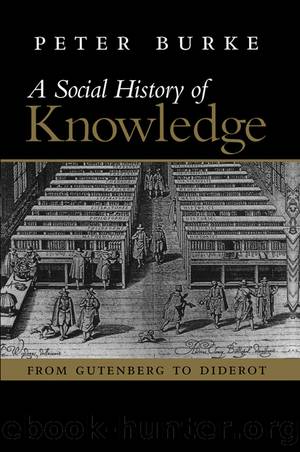A Social History of Knowledge by Burke Peter;

Author:Burke, Peter;
Language: eng
Format: epub
Publisher: Polity Press
CENSORSHIP
Much of the information discussed so far was ‘TOP SECRET’, as the British army used to describe it. For this reason and others a system of control or censorship was in operation. In Venice, for example, access to archives was strictly controlled. Even the doge was not allowed to enter the archive alone. Only members of the Senate could enter the archive, and only members of the Collegio could remove documents. To avoid the temptation to read the papers in his care, the keeper of the archive was supposed to be illiterate.79
The most famous and widespread censorship system of the period was that of the Catholic Church, associated with the ‘Index of Prohibited Books’. The Index was a printed catalogue – perhaps better described as an ‘anti-catalogue’ – of the books which the faithful were forbidden to read. Actually there were many local indexes but the important ones were those issued by papal authority and binding on the whole Church.
The Index appears to have been invented as an antidote to Protestantism and printing. At the Reformation, the Protestants claimed that knowledge was on their side. The Englishman John Foxe, for example, author of a famous ‘book of martyrs’, claimed that ‘either the pope must abolish knowledge and printing, or printing must at length root him out.’ To this claim the Index offered a response. It was an attempt to fight print with print, to control the book population. The model index, issued in 1564, began with a set of general rules forbidding three main types of book: the heretical, the immoral and the magical. Then came an alphabetical list of authors and titles, the authors divided into ‘first class’ (all their writings being prohibited) and second class (in which case the ban extended only to specific works). The censorship system was complex, with three rival institutions competing to control it in Rome itself. It was resisted by printers, booksellers and readers, often with success. It may have been counter-productive, encouraging the curiosity of the faithful.80 All the same, it did obstruct the circulation of knowledge in the Catholic world.
Most of the books on the Church’s list were works of Protestant theology, but the list also included some books on other topics which happened to have been written by heretics. For example, in 1572, a professor of medicine at the university of Padua found it difficult to acquire a copy of Zwinger’s famous encyclopaedia (above, 95) because it was the work of a Protestant, while a Madrid bookseller found himself in trouble in 1618 for similar reasons, when Conrad Gesner’s treatise on fish was found in his shop.81 In similar fashion the Acta Eruditorum of Leipzig, one of the most famous learned journals of the seventeenth century, was suspect because of its Protestant editors.
The Catholic Church was not alone in its concern with controlling the book population. Protestant censorship began as early as the 1520s in Strasbourg, Zurich and Saxony, the works prohibited including not only Catholic polemic but also the works of radical reformers such as the Anabaptists.
Download
This site does not store any files on its server. We only index and link to content provided by other sites. Please contact the content providers to delete copyright contents if any and email us, we'll remove relevant links or contents immediately.
Nudge - Improving Decisions about Health, Wealth, and Happiness by Thaler Sunstein(6636)
iGen by Jean M. Twenge(4702)
The Fire Next Time by James Baldwin(4346)
Adulting by Kelly Williams Brown(3674)
The Sports Rules Book by Human Kinetics(3590)
The Hacking of the American Mind by Robert H. Lustig(3581)
The Ethical Slut by Janet W. Hardy(3505)
Captivate by Vanessa Van Edwards(3302)
Mummy Knew by Lisa James(3170)
In a Sunburned Country by Bill Bryson(2948)
Ants Among Elephants by Sujatha Gidla(2926)
The Worm at the Core by Sheldon Solomon(2922)
Suicide: A Study in Sociology by Emile Durkheim(2611)
The Slow Fix: Solve Problems, Work Smarter, and Live Better In a World Addicted to Speed by Carl Honore(2575)
Humans of New York by Brandon Stanton(2381)
Handbook of Forensic Sociology and Psychology by Stephen J. Morewitz & Mark L. Goldstein(2379)
Blackwell Companion to Sociology, The by Judith R. Blau(2320)
The Happy Hooker by Xaviera Hollander(2274)
Outliers by Malcolm Gladwell(2259)
